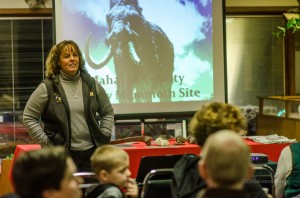Mahaska County Naturalist Talks Mammoths

Mahaska County Naturalist Laura DeCook gave a presentation recently on the Wooley mammoths’ bones that have recently been discovered in Mahaska County. (photo by Ken Allsup/Oskaloosa News)
Oskaloosa, Iowa – The dig for mammoth bones has been going on for over a couple of years now in Mahaska County. Laura DeCook, Mahaska County Naturalist, recently took visitors on a virtual tour of that site.
She told a story of how the bones were first discovered and about some of the most recent developments that showcase what Iowa looked like some 13,000 years ago. The mammoths discovered here in Mahaska County are of the Woolly mammoth variety. At one point, they had thought there was also a Colombian mammoth. “I know the mammoth has been of great interest to people,” said DeCook.
The presentation by DeCook, was meant to show that there is more going on at the site than digging up bones. “The story is also more than just a mammoth,” said DeCook.
Geologists have been using the site to study what Iowa looked like in past geological events that have helped make the state what it is today. Samples from the site have revealed spruce needles, pollen, along with a 13,000-year-old tree stump. Some of this material has been so well preserved that you could have used it to build a fire.
Scientists from all around the state, along with a multitude of volunteers, have excavated what started out as a small pit into a world-class dig site. The discoveries and research taking place at this rural Mahaska County farm has captured the attention of national media, regional and local media as well.
What has been amazing about this dig is that three confirmed woolly mammoths are located at the spot. To this point no other animal from the same period of time has been discovered at the site. It was originally believed the location was a plunge pool that trapped the animals. More recent discoveries have come about at the site, because of the geological work being conducted, and has led scientists to believe the location was fed by a natural spring that welled up from below ground.
The Mahaska County conservation Board is planning on building a new nature center at the Caldwell Park location in the near future. The mammoth bones are figured to be prominent in that upcoming expansion.
If you are interested in volunteering at the site in upcoming digs, you can contact DeCook at the Russell Wildlife Center at 641.673.9327 or by email to decook@mahaskacounty.org.















